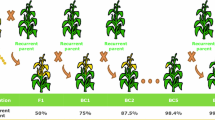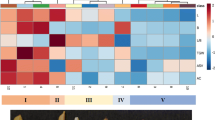Abstract
A comparative metabolite profiling approach based on gas chromatography-mass spectrometry (GC/MS) was applied to investigate the impact of genetic background, growing location and season on the chemical composition of maize grain. The metabolite profiling protocol involved sub-fractionation of the metabolites and allowed the assessment of about 300 distinct analytes from different chemical classes (polar to lipophilic), of which 167 could be identified. A comparison, over three consecutive growing seasons, of the metabolite profiles of four maize cultivars which differed in their maturity classification, was carried out using principal component analysis (PCA). This revealed a strong separation of one cultivar in the first growing season, which could be explained by the immaturity of the kernels of this cultivar compared with others in the field trial. Further evaluations by pair-wise comparison using Student’s t-test and analysis of variance (ANOVA) showed that the growing season was the most prominent impact factor driving variation of the metabolite pool. An increased understanding of metabolic variation was achieved by analysis of a second sample set comprising one cultivar grown for 3 years at four locations. The applied GC/MS-based metabolite profiling demonstrated the natural variation in maize grain metabolite pools resulting from the interplay of environment, season, and genotype.








Similar content being viewed by others
References
Arruda, P., da Silva, W. J., & Teixeira, J. P. F. (1978). Protein and free amino acids in a high lysine maize double mutant. Phytochemistry, 17, 1217–1218.
Ashton, W. D. (1972). The Logit Transformation with special reference to its uses in bioassay. London: Charles Griffin & Company Limited.
Ausloos, P., Clifton, C. L., Lias, S. G., Mikaya, A. I., Stein, S. E., Tchekhovskoi, D. V., et al. (1999). The critical evaluation of a comprehensive mass spectral library. Journal of the American Society for Mass Spectrometry, 10, 287–299.
Bundessortenamt. (2008). Beschreibende Sortenliste - Getreide, Mais, Ölfrüchte, Leguminosen (großkörnig), Hackfrüchte 2008 (außer Kartoffeln). Hannover: Bundessortenamt.
Castro, C., & Manetti, C. (2007). A multiway approach to analyze metabonomic data: a study of maize seeds development. Analytical Biochemistry, 371, 194–200.
Daftary, R. D., & Pomeranz, Y. (1965). Changes in lipid composition in maturing wheat. Journal of Food Science, 30, 577–582.
Duvick, D. N. (1952). Free amino acids in the developing endosperm of maize. American Journal of Botany, 39, 656–661.
FAO (2005) ProdSTAT: Crops, food and agriculture organization of the United Nations.
Fernie, A. R., & Schauer, N. (2008). Metabolomics-assisted breeding: a viable option for crop improvement? Trends in Genetics, 25, 39–48.
Fiehn, O. (2001). Combining genomics, metabolome analysis, and biochemical modelling to understand metabolic networks. Comparative and Functional Genomics, 2, 155–168.
Fiehn, O. (2002). Metabolomics—the link between genotypes and phenotypes. Plant Molecular Biology, 48, 155–171.
Fiehn, O., Kopka, J., Dormann, P., Altmann, T., Trethewey, R. N., & Willmitzer, L. (2000). Metabolite profiling for plant functional genomics. Nature Biotechnology, 18, 1157–1161.
Frank, T., Meuleye, B. S., Miller, A., Shu, Q.-Y., & Engel, K.-H. (2007). Metabolite profiling of two low phytic acid (lpa) rice mutants. Journal of Agricultural and Food Chemistry, 55, 11011–11019.
Frenzel, T., Miller, A., & Engel, K.-H. (2002). Metabolite profiling-a fractionation method for analysis of major and minor compounds in rice grains. Cereal Chemistry, 79, 215–221.
Frenzel, T., Miller, A., & Engel, K.-H. (2003). A methodology for automated comparative analysis of metabolite profiling data. European Food Research and Technology, 216, 335–342.
Greiff, W. R., Morgan, W. T., & Ponte, J. M. (2002). The role of variance in term weighting for probabilistic information retrieval. Proceedings of the Eleventh International Conference on Information and Knowledge Management, ACM.
Harrigan, G. G., Stork, L. G., Riordan, S. G., Reynolds, T. L., Ridley, W. P., Masucci, J. D., et al. (2007a). Impact of genetics and environment on nutritional and metabolite components of maize grain. Journal of Agricultural and Food Chemistry, 55, 6177–6185.
Harrigan, G. G., Stork, L. G., Riordan, S. G., Ridley, W. P., MacIsaac, S., Halls, S. C., et al. (2007b). Metabolite analyses of grain from maize hybrids grown in the United States under drought and watered conditions during the 2002 field season. Journal of Agricultural and Food Chemistry, 55, 6169–6176.
Hazebroek, J., Harp, T., Shi, J., & Wang, H. (2007). Metabolomic analysis of low phytic acid maize kernels. In B. J. Nikolau & E. S. Wurtele (Eds.), Concepts in plant metabolomics (pp. 221–237). Berlin, Germany: Springer.
Hirel, B., Andrieu, B., Valadier, M.-H., Renard, S., Quilleré, I., Chelle, M., et al. (2005). Physiology of maize II: Identification of physiological markers representative of the nitrogen status of maize (Zea mays) leaves during grain filling. Physiologia Plantarum, 124, 178–188.
IPS, Institut für Pflanzenschutz (2009). Agrarmeteorologisches Messnetz Bayern, Bayerische Landesanstalt für Landwirtschaft (LfL).
Jackson, J. E. (1991). A user’s guide to principal components. New York: Wiley.
Kamal-Eldin, A., Appelqvist, L. Å., Yousif, G., & Iskander, G. M. (1992). Seed lipids of Sesamum indicum and related wild species in Sudan. The sterols. Journal of the Science of Food and Agriculture, 59, 327–334.
Kopka, J., Schauer, N., Krueger, S., Birkemeyer, C., Usadel, B., Bergmuller, E., et al. (2005). GMD@CSB.DB: The Golm Metabolome Database. Bioinformatics, 21, 1635–1638.
Lozovaya, V., Ulanov, A., Lygin, A., Duncan, D., & Widholm, J. (2006). Biochemical features of maize tissues with different capacities to regenerate plants. Planta, 224, 1385–1399.
Meyna, S. (2005). Freie und triglycerid-gebundene Hydroxyfettsäuren in Gerste und Malz und ihre Bedeutung für die Geschmacksstabilität des Bieres, Fakultät III (Prozesswissenschaften), Technische Universität Berlin, pp. 126.
Miller, L. T. (1982). Single derivatization method for routine analysis of bacterial whole-cell fatty acid methyl esters, including hydroxy acids. Journal of Clinical Microbiology, 16, 584–586.
Miyanishi, T., Tutimoto, S., Ogura, M., & Iio, T. (1991). Studies on the taste and flavor of sweet corn. I. Changes in chemical components in sweet corn (cv. Golden Earlipak) kernels during maturation. Nippon Shokuhin Kogyo Gakkaishi, 38, 758–764.
Reynolds, T. L., Nemeth, M. A., Glenn, K. C., Ridley, W. P., & Astwood, J. D. (2005). Natural variability of metabolites in maize grain: Differences due to genetic background. Journal of Agricultural and Food Chemistry, 53, 10061–10067.
Ridley, W. P., Sidhu, R. S., Pyla, P. D., Nemeth, M. A., Breeze, M. L., & Astwood, J. D. (2002). Comparison of the nutritional profile of glyphosate-tolerant corn event NK603 with that of conventional corn (Zea mays L.). Journal of Agricultural and Food Chemistry, 50, 7235–7243.
Roessner, U., Wagner, C., Kopka, J., Trethewey, R. N., & Willmitzer, L. (2000). Simultaneous analysis of metabolites in potato tuber by gas chromatography-mass spectrometry. Plant Journal, 23, 131–142.
Scherz, H., & Senser, F. (2000). Food composition and nutrition tables (6th ed.). Stuttgart, Germany: Medpharm Scientific Publication, CRC Press.
Seebauer, J. R., Moose, S. P., Fabbri, B. J., Crossland, L. D., & Below, F. E. (2004). Amino acid metabolism in maize earshoots. Implications for assimilate preconditioning and nitrogen signaling. Plant Physiology, 136, 4326–4334.
Ter Braak, C. J. F., & Gremmen, N. J. M. (1987). Ecological amplitudes of plant species and the internal consistency of Ellenberg’s indicator values for moisture. Plant Ecology, 69, 79–87.
Voelker, T., & Kinney, A. J. (2001). Variations in the biosynthesis of seed-storage lipids. Annual Review of Plant Physiology and Plant Molecular Biology, 52, 335–361.
Weber, E. J. (1969). Lipids of maturing grain of corn (Zea mays). I. Changes in lipid classes and fatty acid composition. Journal of the American Oil Chemists’ Society, 46, 485–488.
Wendland, M., Diepolder, M., & Capriel, P. (2007). Leitfaden für die Düngung von Acker- und Grünland. Bayerische Landesanstalt für Landwirtschaft (LfL).
Xu, Z., & Godber, J. S. (1999). Purification and identification of components of γ-Oryzanol in rice bran oil. Journal of Agricultural and Food Chemistry, 47, 2724–2728.
Young, T. E., & Gallie, D. R. (2000). Programmed cell death during endosperm development. Plant Molecular Biology, 44, 283–301.
Acknowledgments
This work was financially supported by the EU FP6 project SAFEFOODS (contract no. Food-CT-2004-506446, Promoting Food Safety through a New Integrated Risk Analysis Approach for Foods—SAFEFOODS). The technical assistance by Martina Denk is gratefully acknowledged.
Author information
Authors and Affiliations
Corresponding author
Electronic supplementary material
Below is the link to the electronic supplementary material.
Rights and permissions
About this article
Cite this article
Röhlig, R.M., Eder, J. & Engel, KH. Metabolite profiling of maize grain: differentiation due to genetics and environment. Metabolomics 5, 459–477 (2009). https://doi.org/10.1007/s11306-009-0171-5
Received:
Accepted:
Published:
Issue Date:
DOI: https://doi.org/10.1007/s11306-009-0171-5




